The Fairytale of Giverny, Home to Claude Monet
The story of Monet’s Garden Giverny – with the transformation from an unloved area of land, constrained by walls, to a place of daily inspiration and joy, for the legendary impressionist – is almost a fairy tale.
It seems fitting that Giverny, only 50 miles west and slightly north of the metropolis of Paris, should become an abundant and continually flowering legacy to it’s creator, Claude Monet. Giverny sits on the “right bank” of the Seine in the department of Haute-Normandie, France.
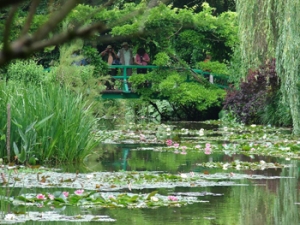
The Fairytale of Giverny
In 1883, Monet first noticed the village of Giverny whilst on a train journey. He saw it from the window and decided he would move there. It had a small population then of around 300 people. He rented a house and the land around it and lived there with his wife Alice, and their eight children. The land sloped gently down from the house to the road and was planted with an orchard and enclosed by high stone walls. A few years later, in 1890 Monet had enough money to buy the house and land outright. He lived in the house with its famous pink brick façade until his death in 1926. He and many members of his family are interred in the village cemetery.
A number of American Impressionist artists also settled to work in Giverny, drawn by the landscapes, the overall atmosphere, and the presence of Monet. They became known as “The Giverny Group.” World War I largely marked the end of the art colony.
Clos Normand Flower Garden
Monet then put his energies into creating the magnificent gardens at Giverny that remain today. There are two parts to the garden, a flower garden called Clos Normand in front of the house and a Japanese inspired water garden on the other side of the road. The two parts of Monet’s garden contrast and complement one another.
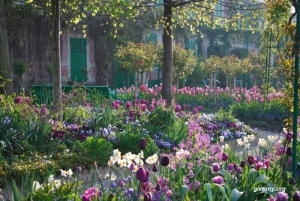
It is said that Monet began by having the pines cut down, keeping only the
two yews closest to the house to please Alice. The land is divided between flowerbeds and fruit and ornamental trees. He mixed the simplest flowers, such as daisies and poppies, with rare specimens. He married flowers according to colour and shape and let them to grow freely.
Always on the look out for rare varieties, Monet would buy young plants at great expense. “All my money goes into my garden,” he said. But also: “I am in raptures.”
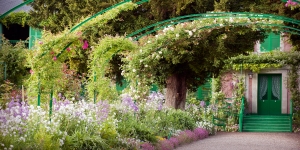
The Water Garden and the Famous Water Lilies
In 1893, ten years after his arrival at Giverny, Monet bought the piece of land neighbouring his property on the other side of the railway. It was crossed by a small brook, the Ru. He had the first small pond dug which later was enlarged to its present day size. The water garden was inspired by the Japanese gardens that Monet knew from the prints he collected avidly.
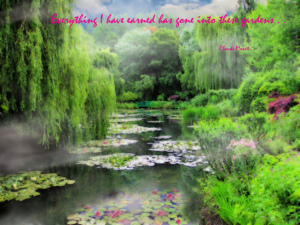
Monet would find his inspiration in this water garden for more than twenty years. It also has the famous Japanese bridge covered with wisterias, other smaller bridges, weeping willows, a bamboo wood and above all the famous nympheas.
The Japanese Bridge
Monet had the bridge built in beech by a local craftsman. By the time the garden was restored the bridge was too damaged to be saved and had to be rebuilt. The wisterias were planted by Monet.

Restoring Monet’s House and Garden
After the death of Monet in 1926, his son Michel inherited the house and garden at Giverny, but he never lived there. It was Monet’s step-daughter Blanche who took care of the property in the early days. Sadly, after the Second World War, the house and garden became neglected and In 1966 Michel Monet left it to the Academie des Beaux-Arts.
Thanks to generous donations, it took almost ten years to restore the garden and the house their former magnificence. The huge Nymphea’s studio was restored and the precious collection of Japanese engravings was displayed in several rooms. The pond had to be dug again and the same flower species were planted.
The property has been open to the public since September 1980.
Painting at Giverny
Some of Monet’s most famous paintings were of his garden in Giverny, famous for its rectangular Clos Normand, with its archways of climbing plants, and the water garden, with the Japanese bridge over the pond with the water lillies and wisteria.
It is said that in the last half of his life, Monet’s world shrank to encompass only Giverny. But his artistic vision expanded as he painted smaller details on bigger canvases and helped invent modern abstract art.
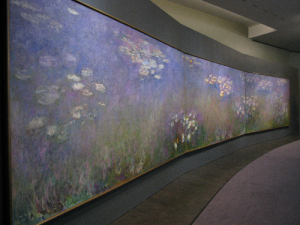
In the last half of his life (beginning in 1912), Monet began to go blind with cataracts. He used larger canvases and painted fewer details. The true subject is not really the famous water lilies, but the changing reflections on the pond’s surface — the blue sky, white clouds, and green trees that line the shore.
Monet’s Garden’s at Giverny Today
The house became a popular tourist attraction thanks to the Claude Monet Foundation, particularly in the summer when the flowers are in bloom. Around 500 000 visitors discover Monet’s gardens each year during the seven months that it is open. One is able to walk on the side alleys and all around the garden to admire all its perspectives.
Today an underground passage gives access the water garden. At the time of Monet it was necessary to cross the railway and the road. It is permitted to walk on the Japanese bridge and explore all the hidden recesses of the water garden.
Close by, the bright, modern Museum of the Impressionists houses temporary exhibits of Impressionist art . To reach it, turn left after leaving Monet’s place and walk just 200 yards.
See Monet’s Paintings on Show at London Exhibition
Visit the latest exhibition at the Painting the Modern Garden at the Royal Academy. Using the work of Monet as a starting point, this landmark exhibition examines the role gardens have played in the evolution of art from the early 1860s through to the 1920s. A must see!
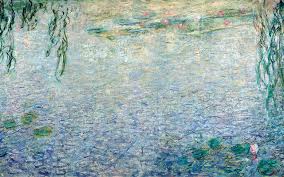
Exclusive Trip to Giverny – Paint Monet’s Garden
2 – 10 June 2016
If your dream is to paint in Monet’s garden then this is your chance. The garden is always full of colour but early June is normally the start of the water lilies flowering season. When the day visitors have departed and with special permission artist groups are allowed in, to paint the garden bathed in the soft evening light.
Join a special painting holiday with expert guidance from famed botanical artist Pamela Kay and paint the glorious private gardens in the Loire as well as Monet’s garden at Giverny.
Read more on how you can – Paint the water lilies in Monet’s Garden

